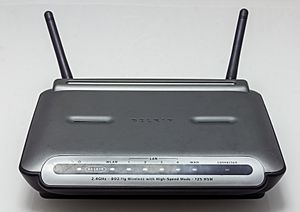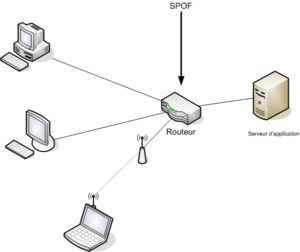Router facts for kids
A router is like a traffic cop for the internet! It's a special computer that helps send information (data) between different computer networks. Routers make sure your internet traffic goes to the right place, taking the fastest way possible. They use special rules called routing protocols to figure out the best path for data.
Inside a router, you'll find parts like a special operating system, RAM (for temporary storage), NVRAM (for settings), flash memory (like a small hard drive), and processors (the 'brain'). They also have several network interfaces, which are like ports for cables. Routers come in many sizes, from small ones you can hold to very large ones used by big companies.
If you have an internet connection at home, you probably have a router. This is the first router your computer connects to when you want to go online. It's also known as your default gateway because it's your main entrance to the internet. This gateway usually has the lowest IP address (which is like a phone number for a computer) in your subnet (a group of IP addresses).
When you visit a website, like www.wikipedia.org, your computer first finds its IP address using a service called DNS. Once it has the address, your computer connects to your gateway router. Your gateway then sends the data to a router at your ISP (Internet Service Provider). From there, the data travels through many other routers on the internet until it reaches its destination.

In small networks, like those in homes, small businesses, or schools, the router often does something called NAT. This makes all outgoing connections look like they come from just one address. Usually, incoming connections are only allowed if they are replies to connections that a computer inside the network started.
Routers connect two or more networks and direct the flow of data between them. These networks can be physical (connected by cables to a port) or logical (not directly tied to a specific port). Sometimes, you might hear the term layer 3 switch. This term is often used like 'router', but it's a more general way to describe a device that connects Ethernet devices in a LAN but can also route traffic.
Router operating systems are divided into two main parts:
- The Control Plane: This is where the router learns the best way to send data to a specific destination. It figures out the best path.
- The Forwarding Plane: This is where the router actually sends the data to its destination, doing the real work of moving information.
Related pages


